WebDAV Setup
What is WebDAV?
WebDAV access allows users which can edit course files to do so from a convenient WebDAV "Web Folder"/Mountpoint which acts like a local drive.
Configuring WebDAV in Moodle
To set up WebDAV access in your Moodle installation:
- In Admin->Server->WebDAV Set webdavenable to Yes.
- The 'moodle/site:webdav' capability controls who can connect - by default the "Course Creator" role has it. Assign the role at the system level for users to be able to connect.
- If you want to restrict WebDAVaccess so it is only accessible from the local LAN, use the webdavsubnet setting.
(This feature will be available after v1.9)
Note: For the WebDAV feature to work, the PHP setting magic_quotes_gpc must be off.
Configuring WebDAV on Microsoft Windows Server 2003 R2 (Service Pack 2), IIS V6.0
Configure Windows Server
First we need to install WebDAV on the server. Note: when you promote a basic Windows Server 2003 installation to an application server, it installs various IIS 6 components but WebDAV isn’t one of them.
Install and Enable WebDAV on the Server
To install WebDAV on the IIS 6 machine, use Add or Remove Programs in Control Panel and run the Windows Components Wizard. You can find WebDAV under Application Server -> Internet Information Services -> World Wide Web Service -> WebDAV Publishing.
Once WebDAV is installed it needs to be enabled. Check the WebDAV option under the Web Service Extensions node in IIS Manager.
Configure IIS
Configuring a new virtual directory in IIS is a two-step process:
- Create a new virtual directory using the Virtual Directory wizard
- Configure the access permissions on the new virtual directory
Create New Virtual Directory
- Open IIS and right-click on your Moodle website. Select New -> Virtual Directory... from the pop-up menu.
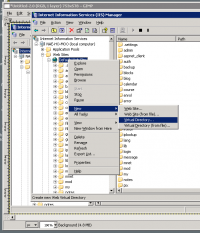
- Select New -> Virtual directory... from the pop-up menu. The Create New Virtual Directory Wizard is displayed.

- Call the new virtual directory Moodledata.
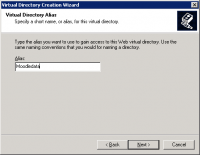
- Specify the path to the Moodledata directory.
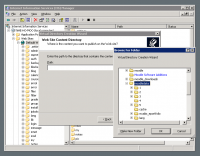
- Ensure the new virtual directory has Read, Write and Browse permissions.

- Press the Finish button to create the new virtual directory.
Configuring Virtual Directory Properties
- Right-click on the new virtual directory and select Properties from the pop-up menu.

- Ensure that Read, Write, Directory browsing, and Log visits are checked. Ensure Index this resource is unchecked.
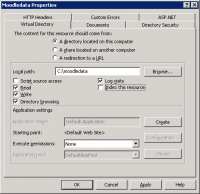
- Click on the Directory Security tab and press the Authentication and access control Edit... button
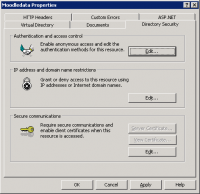
- Authenticated access configuration will depend on your needs. Basic access will require you to uncheck Enable anonymous access and check Basic authentication (password is sent in clear text). You may get a warning about security:
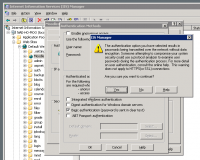
- Your new virtual directory is ready for testing.

Testing WebDAV on Windows XP/Vista
Note: Internet Explorer 8.0 no longer supports web folders. See this blog post from David Conner for details. Instead, you will need to map a network drive (instructions on mapping a network drive are also given in David's blog post).
See Also
- WebDAV Connect
- Some discussions at Using Moodle:
- WebDAV extension for Moodle discussion from 2006
- WebDAV for Moodledata discussion from 2008
- WebDAV for "Course Files" in 2.0 discussion from 2009